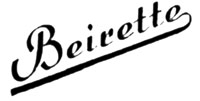
Beier was a camera company in Freital near Dresden initially best known for its folding cameras, some of which can be found elsewhere on this site (Rifax and Precisa
). In 1958, whilst part of East-Germany, it started to build a range of small 35mm cameras, the Beirette series. It was a rather successful range of cameras that continued production till the end of the 1980s, and during that time went through various advances. I prefer the earliest models that were made of metal and had more character than the later ones.
A very comprehensive website about Beier and its cameras can be found at www.beier-kamera.de (in German).
Beira
Before we delve into the Beirettes, a little history first. 35mm cameras weren't really introduced until the very late 1920s, when Leica came out with their Leica I. Several companies such as Zeiss Ikon, Kodak and Welta followed several years after, and so did Beier, when in 1931 they introduced the Beira, which was quite an unusual camera for the time. It had quite a wide, tapered body with a pop-out lens board on which shutter and lens were mounted. It didn't have a rewind knob, so needed to be used with take-up cassettes, and in fact it also needed a supply cassette as a regular 35mm film cassette would not fit. This is not a surprise, as 35mm cassettes as we known them weren't introduced until 1934 by Kodak together with their first Retina, so after introduction of the Beira.
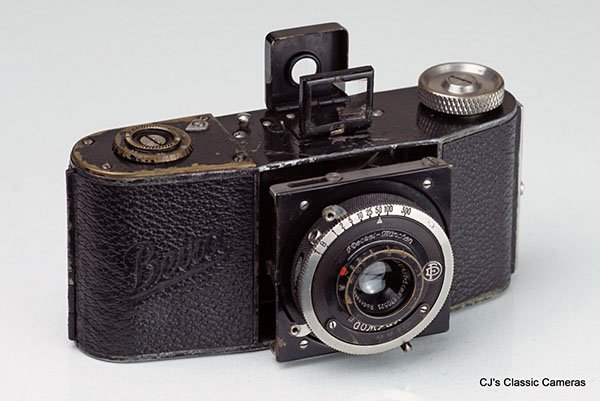
A 1933 Beier Beira with Rodenstock-Trinar-Anastigmat 50mm f/4.5 lens in Compur shutter.
Interestingly, the camera had a roller instead of a sprocket wheel. Therefore, it could use unperforated film which allowed a larger frame size than the standard 36x24mm of 135 film, and indeed the Beira had a 40x31mm film frame.
The most interesting variant of the Beira was the one with a prismatic telescope rangefinder called the 'Okula' build on. It was introduced a few years after the original Beira and could be used with regular 35mm film cartridges, although it still needed a dedicated uptake cassette.
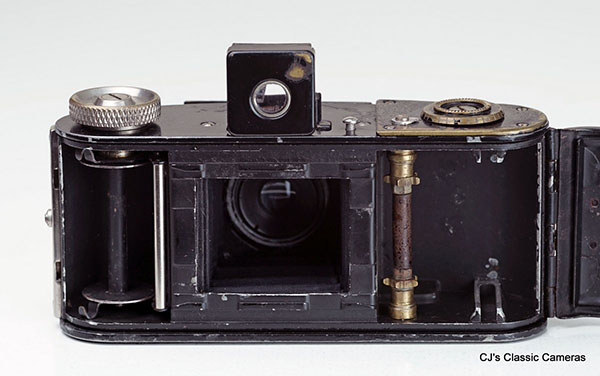
Interior of the Beier Beira. Note that on this example the original roller has been replaced by a regular film sprocket for 35mm film. However, only an 828 film take-up spool will fit on the uptake side, which is rather confusing as that is an unperforated film with paper backing. I suppose one could use regular 35mm film loaded into the dedicated Beira supply cassette (which I don't have) and wind it onto an 828 spool, but this would require unloading in the dark.
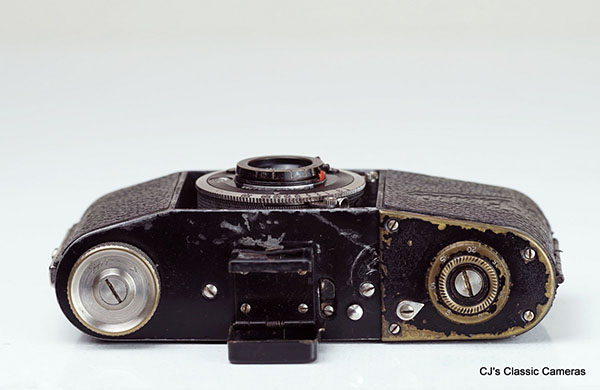
Top view of the Beira to illustrate the pop out lens board. Move mouse over the image to see it extended. Note the frame counter in the right corner of the camera, and the small pointy lever which is connected to the roller/sprocket wheel. When winding the film one had to stop when this small lever had made a full rotation and the frame counter moved up by one frame, there was no automatic wind stop.
Beirette v.1
The first Beirette was a viewfinder camera with wind lever (apparently the first East-German camera to do so) and a prominent shutter release button on the shutter base. On the back it had a parallax switch with two settings marked N ('nah' or 'near') and infinity. It had a Junior shutter, the East-German equivalent of a Pronto, and a either a coated Ludwig Meritar 45mm f/2.9 or Meyer-Optik Trioplan 45mm f/3.5 lens. The frame counter was visible through a little window under the rewind knob. The name Beirette was engraved on the front of the top housing. Because of the shutter, it is sometimes called Beirette Junior.
It was quite a simple camera at a time when other brands were bringing out more and more advanced cameras, but even at that time it was true that 'the best camera is the camera that you have with you'. It was light and easy to handle, which may explain its popularity.
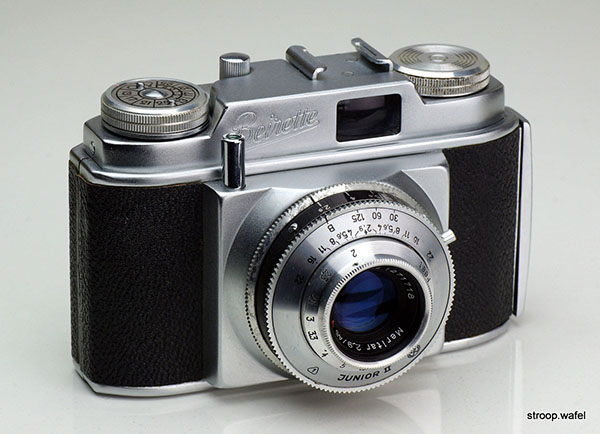
The Beirette I, small but handsome.
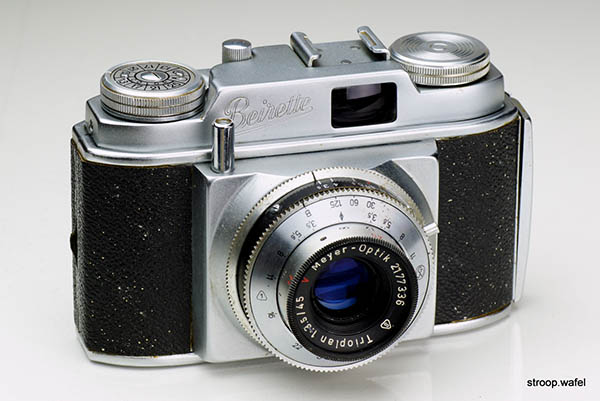
The version with Meyer-Optik Trioplan 45mm f/3.5 lens.
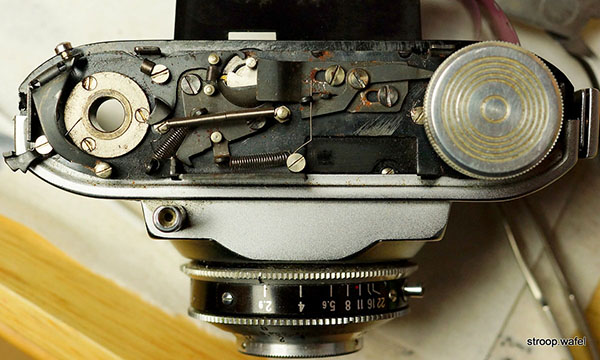
Winding mechanism of the Beirette I. The top housing was tricky to remove, mainly due to the wind knob. I found that the easiest way to remove it was to rotate the winding spool counter clockwise (film direction) while holding the wind knob, this will push the knob off. The levers on the top right-hand side operate the frame counter.
Beirette v.2
The 1963 second version's only difference was the shutter release, which has been moved from the top to the side of the shutter base. Where the shutter release used to be was a remote release socket.

The second Beirette with different shutter release.
Beier-Matic
The Beier-matic was a more modern looking version of the Beirette and included a lightmeter, semi-automatic exposure and a bright-frame viewfinder. Not much info can be found about this model, but it was introduced around 1961. A curious feature was the rewind lever, which was integrated in the accessory shoe. As far as I am aware this was the only Beirette 35mm camera with lightmeter.
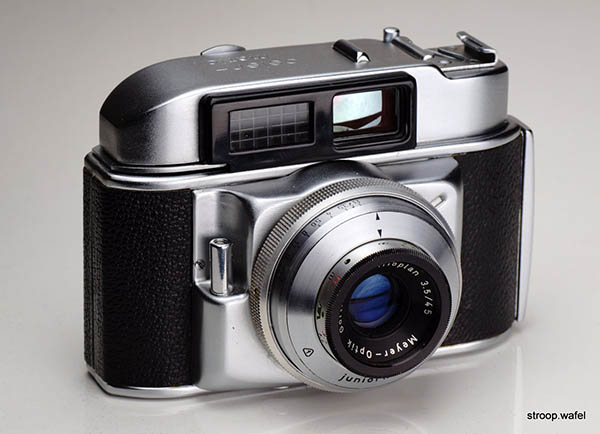
A Beier-matic with Trioplan lens and Juniormat shutter.
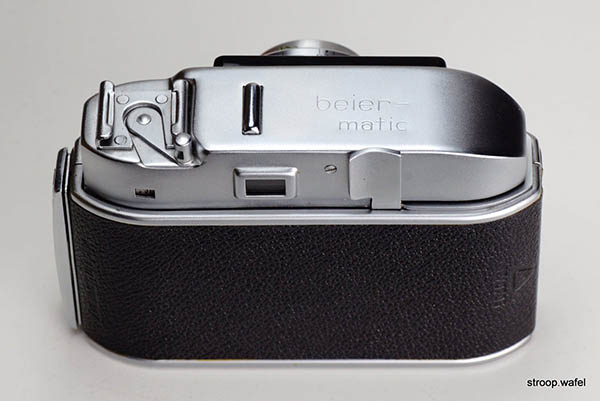
Top rear view of the Beier-matic with showing the accessory shoe with integrated rewind lever. I am not quite sure what the push button on top of the camera is for, I don't see anything happen when I push it.
Beirette v
A later incarnation of the Beirette from 1968, which, even though it was built at 10 years later, still looked rather a lot like the first model. The top housing was a little different, with a slimmer wind lever and an integrated foldable rewind winder, as well as a hot shoe. The viewfinder was a little larger and the lens was still a Ludwig Meritar, the shutter a Priomat.
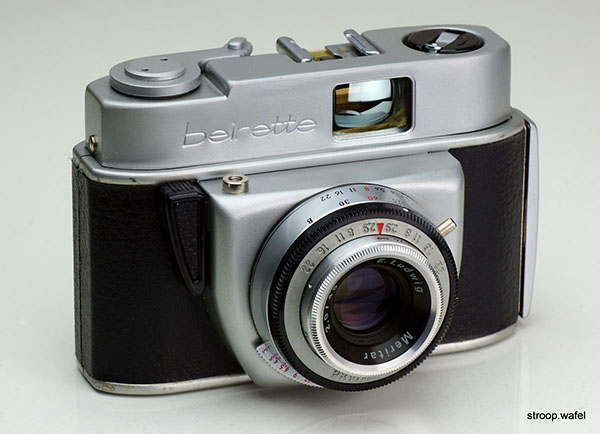
A Beirette v with some new features but still looking rather the same as earlier models. Just visible bottom left from the lens is a serrated tab to adjust the aperture ring, with a strange set of numbers of which I have not really been able to make much sense.
 |
The Beirette v with its original box. In the box is a production note dated 1971. |
Beirette K
The Beirette K looked very similar to the Beirette v above, but was rather unique among the Beirette series, as it did not take 135 film cartridges but used Rapid cassettes instead. As film was transferred from a supply cassette to a take-up cassette, no rewind knob was needed, and instead of a wind lever, the Beirette K had a metal slider at the back that needed to be pushed from right to left to forward the film and cock the shutter. The camera was equipped with a wind lock as well as a double exposure lock, preventing blank or double exposures, respectively.
The camera did not use the ISO setting capabilities of the Rapid cassette system (see Minolta 24 Rapid), as it had a fully manual exposure system, in contrast to the Beirette v above. The lens was the familiar Ludwig Meritar or a Meyer-Optik Domiplan.

A Beirette K with Ludwig Meritar 45mm f/2.9 lens in a shutter marked 'Modell II'. The original grub screws had been replaced by rather oversized versions, but well, at least it makes focussing easier. As can be seen below, the camera had also been robbed of its frame around the rear eye piece as well as the frame counter, unfortunately I had not paid enough attention to the photos of this camera before deciding to buy it. On top of that the shutter does not work despite the camera being described as fully working. Not the first time, Rocky.
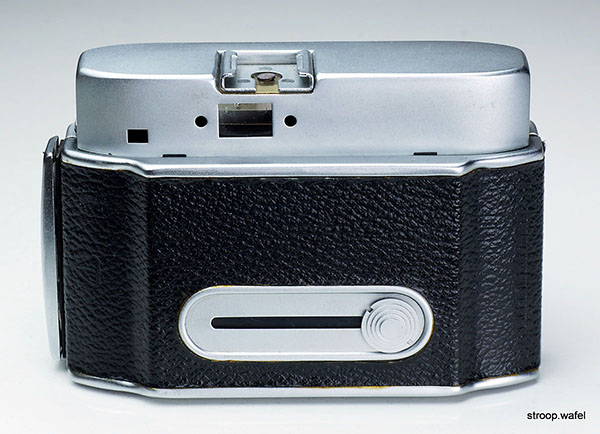
Rear view of the Beirette K showing the film wind slider. Note the thick back plate, which holds the sliding mechanism. This particular model is also equipped with a hot shoe.
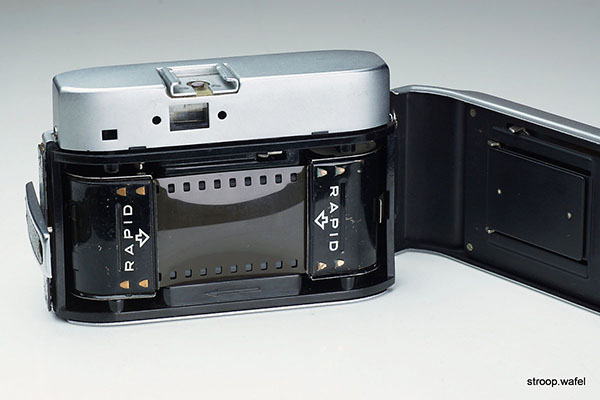
Beirette K with film loaded. Two pins in the sliding mechanism at the back would transfer the film whilst the pin at the top would reset the double exposure lock. As these pins were all coupled it was essential to forward the film with one complete stroke of the slider.
| 
